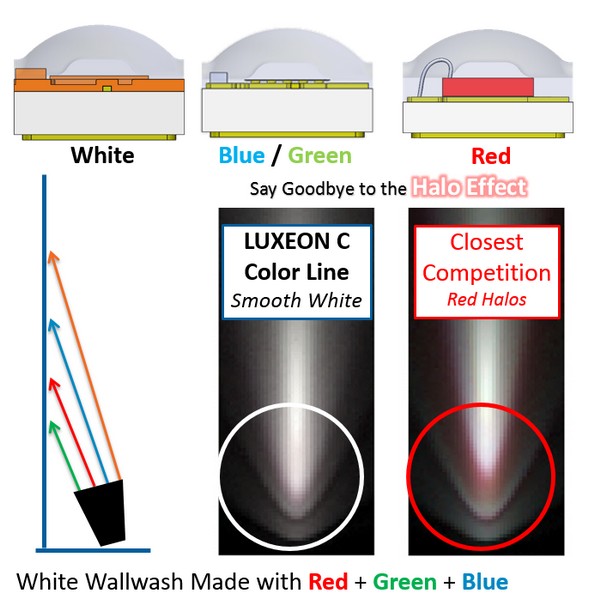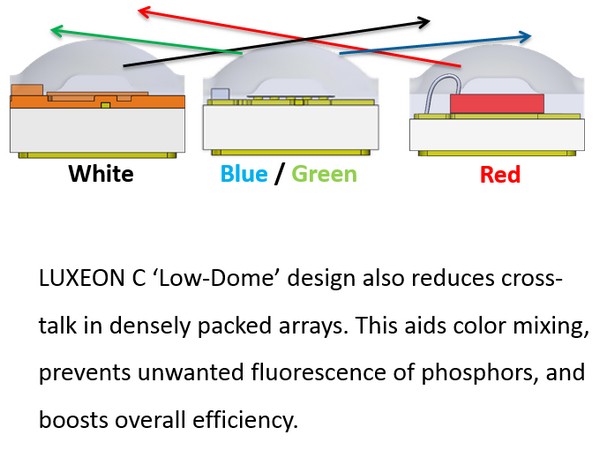Having ventured into the color LED market with its traffic light products in 1998, leading LED manufacturer Lumileds has come a long way with its color LED designs.
A week ahead of Lumileds LUXEON C Color Line launch, the company website was redesigned in monochrome to highlight the importance of color in LEDs. The new LEDs took two years to develop and have made significant breakthroughs in color technology, said Rahul Bammi, Vice President of Marketing and Product Management at Lumileds in an exclusive interview with LEDinside.
 |
|
Rahul Bammi, Vice President of Marketing and Product Management at Lumileds. (All photos courtesy of Lumileds) |
Lumileds makes breakthrough in single color focal length designs
For years the LED industry has struggled to nail the single color focal length design to overcome color mismatch issues. This is where Lumileds LUXEON C Color Line stands out from competing brands. Its competitive edge lies in its single color focal length designs, said Bammi. This particular design can reduce halo effects that can be caused by differences in various color LED wavelengths, explained David Cosenza, the company’s Product Manager for the LUXEON Color LED Family. “Traditional colored LEDs white, blue, green and red not only have different wavelengths, but also different focal lengths ,” explained Cosenza. The different focal lengths can create what is known as the halo effect. Red LEDs in particular are prone to cause halo effects more than other colors because of its different mechanical dimensions that can create an unsightly red halo effect.
 |
|
Halo effects are reduced with Lumileds LUXEON C single focal point designs. |
Another breakthrough design is eliminating the trade-off between flux and source size. Lumileds LUXEON C Color Line has a much simpler optic design to ensure more consistent uniform color. The company has balanced flux gain without magnifying the light source. Lumileds LUXEON C Color Line is much more compact than the previous LUXEON Rebel product line, and is on average about 23% smaller, said Cosenza. Although, the new LEDs are smaller in size, it has maintained the same lumens output, said Bammi.
 |
|
David Cosenza, Product Manager for the LUXEON Color LED Family at Lumileds. |
Cross talk is reduced with the low dome design in new products to allow the color LEDs to be reflected off the dome. The low dome design also reduces cross talk between products, and allows the LED color to be reflected off the dome. Cross talk occurs when closely packed different color LEDs emission interferes with another LED color. Royal blue and white LEDs can be most affected, since the royal blue can excite the white phosphor, explained Cosenza.
 |
However, in mixed color LEDs red can often be a limiting factor because of its sensitivity to LED juncture temperature fluctuations compared to that of blue or white LEDs, said Cosenza. “Its (red LEDs) efficacy can drop as much as 45% when operating at 85 degrees Celsius,” he explained. “In comparison white and blue and green (InGaN dies) LEDs only lose 10%.” The main cause of this difference is AlInGaP material used in the production of red LEDs is much more sensitive to temperature. Regularly, red LEDs driving current is usually 2W to 3W. The company makes its own phosphors, and uses various phosphors for white and PC amber LEDs, said Bammi.
To overcome thermal sensitivity issues, the red LEDs in Lumileds LUXEON C are designed with a much thinner substrate to keep the focal light consistent, noted Cosenza. “Lumileds red LEDs also have a hot/cold factor of 60 compared to competitors’ hot/cold factor of 50,” he added.Many competitors in the industry are also turning to aluminum nitride substrates that have much lower thermal resistance.
Lumileds is also a pioneer in hot testing colored LEDs. The company first introduced hot testing techniques in its white color LEDs during 2009-2010. Many manufacturers in the industry prefer not to put their products through hot testing because it requires longer testing periods and sacrifices seemingly higher performance at room temperature, explained Bammi. Hot testing might even lower products performance parameters or values on paper, which many manufacturers want to avoid so they can quote higher performance number requirements for LEDs. Moreover, hot testing can increase manufacturers overall production costs, said Figo Wang, Senior Analyst, LEDinside.
 |
|
Lumileds new LUXEON C color LED range from left to right: red, white, blue and amber LEDs. |
Lumileds market outlook for the color LED market
The new Lumileds LUXEON C Color Line is mostly aimed at meeting the market demands for architectural and emergency lighting demands, such as for fire trucks and ambulances, said Bammi. The company which has a leading market position in both color and white LED markets has observed distinctive trends among the various color LED sectors. For instance, there is growing demands for architectural RGB LED lighting in China and New Zealand, said Cosenza. In Europe there is a large demand for entertainment lighting, while in the U.S. and Europe emergency lighting has shown significant growth. Markets in Europe, U.S. and China have also shown growing interest in horticultural applications, added Bammi.
Compared to general white LED lighting markets the color LED market is a bit more saturated, observed Cosenza. This is especially evident in emergency vehicle, traffic and signaling applications which have mostly converted to LED years ago. Lumileds is still vying after stage lighting sector, where it has observed growing demands. Stage lighting for instance has more stringent demands for uniform lighting, white lighting quality, and lighting color demands. Shadowing can be a huge concern in stage lighting applications. Other market sectors Lumileds hopes to tap into with the Lumileds LUXEON C Color Line by second half of 2015 covers horticultural, color tunable illumination, environmental friendly coastal turtle lighting and others.
The color LED market is fragmented and statistics on the general market performance is hard to come by, due to the wide range of applications, noted Cosenza. Lumileds has a strong market position in color LEDs, and there are few Asian and Chinese competitors in this market sector, said Bammi. Asian players color LEDs have a pretty low lumen output, which might not meet certain color LED applications high requirements, he added.
Asked when the industry might be able to design a single LED capable of emitting various colors, such as the graphene based LEDs demonstrated by Professor Tian-Ling Ren from Beijing Tsing Hua University, the two LED experts found it to be an interesting concept, but unpractical for the time being. Until manufacturers overcome industrialization of graphene material and make it stable and reliable enough to apply in real world electronic applications, graphene LEDs capable of emitting a multitude of colors is still a decade away, said Bammi. Whether the efficacy can match sapphire based products is another question that graphene LEDs might face after overcoming the first barrier. Color changing LEDs are difficult to design because it incorporates four color LEDs, and do not function smoothly.
Until then designing a phosphor based color LED capable of smooth color mixing and tuning abilities, uniform light distribution and having a single focal point will probably be the ultimate goal for many manufacturers trying to catch up in color LED designs.
(Author: Judy Lin, Chief Editor, LEDinside)
















